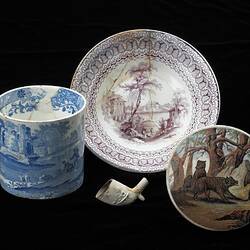Summary
This plate, which has been reconstructed from three fragments, was excavated during one of the digs at the Commonwealth Block site between 1988 and 2003.
Homewares.
Numerous crockery pieces were found all over the Little Lon site. Crockery gives us a glimpse of everyday life in Melbourne in the 1880s. In the houses around Little Lon, residents used decorated crockery. Most pieces were cheap earthenware or stoneware, yet provided colour and cheer. Only a few could afford to buy matching sets, and most china was probably acquired second-hand. Some were once expensive pieces. Householders mixed and matched their crockery from the great range of mass-produced designs available. 'Blue and white' and the 'willow' pattern, was the most popular choice and was produced by English potteries from 1790.
Physical Description
This plate has a raised design and scroll moulding. It is decorated with a blue on white under glaze transfer print which depicts a girl and dog in the centre with images on the rim including a peacock and an eagle. The design is poorly applied and appears to have been smudged.
Physical Description
Blue and white plate. Raised design, transfer print. Girl and dog in centre. 3 pieces, complete. 23 cm diameter. Maker's mark on base: "FAVORITE R.H. & CO" Manufacturer: Ralph Hall & Co., Tunstall, Staffordshire Potteries, 1841 -49.Images on rim include peacocks, eagle. Transfer print. Now conserved by Conservation, for Myer China and Glass Exhibition, 1998 This plate has a poorly-applied design, which appears to have been smudged. It is not flow blue ware. Scroll moulding.
More Information
-
Collection Names
-
Collecting Areas
-
Acquisition Information
Transfer from Heritage Victoria, Industry Superannuation Property Trust, 03 May 2005
-
Manufacture Name
-
Manufacture Date
-
Manufacturer
Ralph Hall and Company, Tunstall, Staffordshire, England, Great Britain, 1841-1849
-
Inscriptions
On base: 'FAVORITE / R H & CO' (TP)
-
Context Number
02/22
-
Site
[CCS] Australia, Victoria, Commonwealth Block, Melbourne
-
Activity
-
Specific Activity
-
Decoration
-
Colour
Blue
-
Moulding
Favorite
-
Form
Curved Marly Rim; Cylindrical Foot (Base)
-
Shape
Round, Scalloped
-
Provenance
England, Staffordshire
-
Classification
-
Category
-
Discipline
-
Type of item
-
Approximate Dimensions
230 mm (Outside Diameter)
-
Object Dimensions
240 mm (Width), 33 mm (Height)
-
Dimensions
3.4 cm (Height), 24 cm (Outside Diameter)
Measurement From Conservation.
-
EAMC Measurements
230 (Outside Diameter)
-
References
Lisa-Mairi Smith: An exploration of nineteenth century ceramics.
104 Pages
-
Keywords


